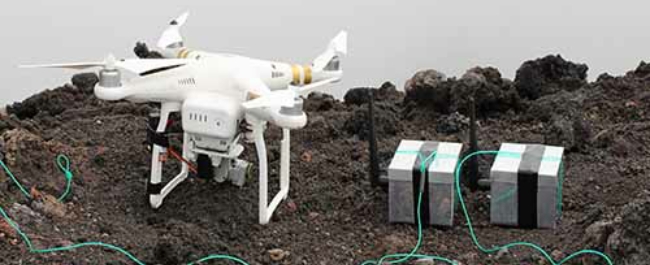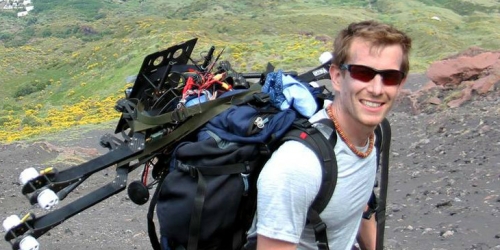Dragon eggs: Drone-deployed remote environmental monitoring

We are developing sensor pods that can be delivered to a volcano by drone, transmitting data wirelessly, enabling the monitoring of inaccessible volcanoes.
The challenge
When monitoring volcanoes, the best data is acquired close to an active vent. Manual installation of sensors at these locations are too risky. Volcanoes are inherently unpredictable, therefore it is difficult to have sufficient monitoring systems deployed when a significant event occurs. Permanent monitoring systems are available, however, the data are best acquired close to a volcano’s active vent. For many locations, the risks are too great for the manual installation of sensors at such proximity, hence the data are comprised or not collected at all! Drones represent an excellent solution to this problem, since they can be equipped with sensors and flown ‘into danger’ whilst people remain at a safe distance. The long-range operations of drones, however, is difficult and has significant time and cost overheads.
What we're doing
The University of Bristol is pioneering the monitoring of volcanic activity using Unmanned Aerial Systems (drones). Due to a strong cooperation between the Aerospace Engineering, Nuclear Physics, and Earth Sciences departments, the group are overcoming remote sensing challenges using the latest technology research. The collected data gives scientists a valuable insight into volcanic systems and how they affect the planet from both a long-term (e.g. degassing of CO2) and short-term (e.g. eruptions causing local devastation) perspective.
This ‘Dragon Eggs’ project seeks to address the problem with long-term monitoring in hazardous environments. The sensor pods (the eggs) we have developed are equipped with a range of state-of-the-art sensors for temperature, humidity, vibrations, and numerous toxic gases, and then deployed using drones in optimal (close-proximity) locations. The eggs have been designed to be self-sufficient and transmit data wirelessly to scientists hence allowing the collection of otherwise inaccessible data sets.
Such an extreme, hazardous environment is as unforgiving to electronics as it is life, so tackling this problem necessitates the development of highly specialised sensor pods that can withstand the harsh conditions around the heart of a volcano and operate for extended periods with extremely low power consumption.
How it helps
The eggs have been designed to be self-sufficient and transmit data wirelessly to scientists, allowing the collection of otherwise inaccessible data sets. A new set of low power electronics was produced for the eggs and a borosilicate glass enclosure, capable of resisting extreme heat, was created by a local glass blower. A borosilicate glass housing is also able to withstand erosion when in close proximity to volcanic activity. This project has enabled the development and field deployment of several eggs, which is a significant advancement of monitoring inaccessible volcanoes. Ultimately, this kind of technology will help us to effectively monitor volcanic activity from afar, and support the development of early warnings, which are so desperately needed by those living in close proximity to volcanic risk.
Investigators
- Kieran Wood (Aerospace Engineering)
- Tom Scott (Physics)
- Tom Richardson (Aerospace Engineering)
- Yannick Verbelen (Physics)
- Suresh Kaluvan (Physics)
- Matt Watson (Earth Sciences)
 Lead researcher profile
Lead researcher profile
Dr Kieran Wood, Senior Research Associate in Advanced Aerial Resources for the Nuclear Industry
Related research centres
Funders
- Cabot Institute for the Environment Innovation Fund to the value of £2800.